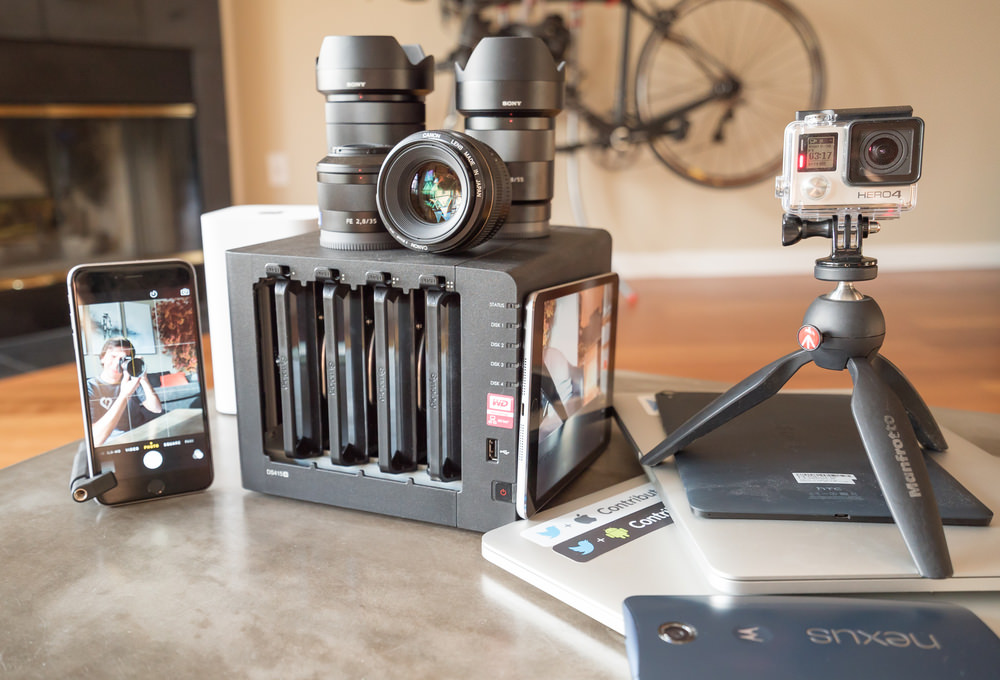Storage
Memory cards & network-attached storage
With the a7R IV pumping out massive ~60MB RAW files (even more for uncompressed RAWs), you need to have gobs of storage at hand, especially if you want to have backup redundancy while traveling. I shot 848GB of photos and videos on my New Zealand trip alone! But having enough storage on the go is not enough — you also need fast storage. I travel with a ton of SD cards since I never empty the cards while traveling: I always have a copy on the card and on my laptop for redundancy until I can back them up to my NAS. While only a few cameras support the new UHS-II standard for the next generation of faster SD cards, there's still a benefit to using UHS-II cards: you can import photos to your computer much faster.
However, there are times when I need to travel light and can't take a tablet or laptop (that I could otherwise use to backup photos to local and external SSD storage). My Africa trip was like this — due to weight restrictions on some of the tiny planes we took between Serengeti camps I left my laptop at home. Since the a7R IV has dual SD card slots I configured it to save a copy of each shot on both cards. Then when I filled a card up, I would put it in a separate SD card holder that I kept either on me or in a different bag for redundancy.
There are purpose-built portable hard drives for this task that can backup SD cards entirely on their own without connecting to a computer. I purchased one such device: the WD My Passport Wireless Pro. While it seems like it can get the job done I actually had to leave it at home too. It was a bit too heavy and bulky to bring along with me.
I have something like 15 or 16 SD cards totaling over a terabyte. There's a handy website dedicated to in-depth SD card benchmarks so it's always worth looking up any card before you buy it, especially if some time has passed and I haven't updated this section in months.
On my last trip I shot with two SD cards in the a7R IV mirroring each other. If you're looking for the best of the best, at this moment it seems like the SanDisk Extreme PRO 300MB/s UHS-II cards and the Sony SF-G UHS-II 300MB/s cards are the leaders here.
Since I've purchased some of my SD cards over time, I have a bunch of older discontinued Lexar cards as well as some of these newer ones.
Satechi USB-C SD card reader
High-quality, supports UHS-II cards. Though I don't use it anymore now that my 2021 MacBook Pro has a built-in SD card reader.
As for having an external SSD, well it's just very likely I'll run out of space backing up SD cards on my laptop if I'm traveling with one. Samsung's USB-C SSDs were just what I was looking for: tiny, lightweight and fast. I have two now — the original 1TB T1 model and the later 1TB T3 model. Though there is a newer T5 model out now.
But if I were looking for such a drive today, I would be considering a Thunderbolt 3 supported NVMe-based SSD like the Samsung X5 or do-it-yourself with an external enclosure.
Network-attached storage
At the heart of my camera setup is a Synology NAS. I use this to archive photos from Lightroom with my desktop PC, as well as back up those local files to several cloud services for safekeeping. My first foray into Synology NAS devices was with a 4-bay DS415+ that I originally wrote about at length in Storage for Photographers (Part 2). That one had four 3TB drives and upgraded RAM.
However, in recent years desktop 3.5" hard drives have gotten much larger (at the time of this writing there are now 15TB models available) so I decided to downsize to a smaller 2-bay model with two Seagate Ironwolf 12TB drives.
I also prefer the smaller DS218+ over other models because it uses a simpler and smaller power brick than other Synology models. I really hated the older style power brick they used that did not make a snug fit. One nice feature of the DS218+ is that RAM is user-upgradeable (previously you had to take apart the whole NAS). As such, I installed an 8GB RAM stick for a total of 10GB of RAM.


